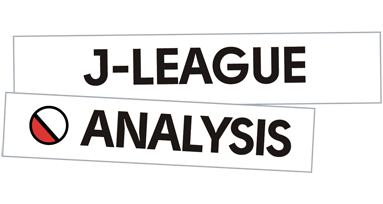The race for third spot is tightening up and for a number of teams, a place in the Asian Champions League qualifiers seems within reach. Matchday 23 of the J League saw runaway leaders Kawasaki Frontale take on fifth-placed Nagoya Grampus, who were coming off their third straight win. Although Kawasaki were clear favourites, recently Nagoya seem to be somewhat of a bogey side for the leaders. In their past two meetings this year, Nagoya had beaten Kawasaki both times 3-0 and 1-0 respectively. Could this be Nagoya’s chance to jump that one step further and put themselves in the position for Asia‘s Champions League qualifiers?
This tactical analysis will highlight the key tactics used by both teams and show the subtle tactical variations used during different phases. This analysis will also show how Nagoya created their chances and kept Frontale on their toes.
Lineups
Lining up in their familiar 4-3-3 formation, Kawasaki started with their number one ‘keeper Sung-Ryong in between the posts. Partnering centre backs Jesiel and Shogo Taniguchi in the back line, Kyohei Noborizato and Miki Yamane provided the width along the flanks as fullbacks. Hidemasa Morita, Kengo Nakamura and Tanaka Ao formed the midfield trio whilst Kaoru Mitoma, Leandro Damião and Akihiro Ienaga were the strike force up front.
Massimo Ficcadenti lined his team up in their 4-2-3-1 formation but as will be touched on later, there were subtle variations in their positioning. Current Australian international and former Borussia Dortmund keeper Mitchell Langerak started in goal, with Yuichi Maruyama and Shinnosuke Nakatani as the centre back pairing. Jae-Suk Oh and Shumpei Naruse bolstered the flanks, with Takuji Yonemoto and Sho Inagaki as the holding midfielders. Brazilian born Mateus made up the midfield with Hiroyuki Abe and Naoki Maeda. Finally, Mu Kanazaki positioned himself as the lone striker.
Using the line of three in build-up
The first 15 minutes for Nagoya were about making sure that they could secure their defence and adapt to the conditions of the game. With only 31% of possession, their main opportunities came from quick counter-attacks by finding one of the advanced midfielders early from a low block. From the 15th minute the possession stats flipped, and Nagoya enjoyed 73% of possession. When Kawasaki didn’t have the ball, they reverted back to a midfield block in a 4-4-2 formation and allowed Nakatani and Maruyama to circulate possession. As the ball shifted out wide, the block slid across, preventing Naruse and Oh from progressing the ball forwards. With the fullbacks being allowed little time on the ball, the challenge for the centre back pairing was then to find an advanced midfielder, since both of Nagoya’s holding midfielders were marked tightly. This situation can be seen below.
We can see that both holding midfielders have been shut down and in anticipation for the ball going wide, Naruse is already marked. Once Yonemoto and Inagaki recognise that they are being man-marked, they drop further to support which opens up space for Maeda to receive the ball. If Maeda was the one being marked, then Naruse would be the player free. Furthermore, the role of Abe is also crucial in this scenario as his dropping run creates the 3v2 behind the first line of defence. When Nakatani and Maruyama are on the ball, if both holding midfielders are marked, they can then split so then Abe becomes the free man. In the scenario where he drops either side of the holding midfielders (not in between), he then becomes the linking player who can make a forward, penetrating pass as will be discussed next.
Instead of the advanced midfielders dropping in to link up with the holding midfielders, the variation to their movements would be linking up to create space in behind the Frontale defence. This would be a common scenario as the markers were starting to pick up on the attacking midfielder’s movements. In the below scenario, to prevent Maeda from receiving the ball facing forward, Kawasaki’s fullback Noborizato and number 14, Nakamura race in to shut Maeda down. In doing so, space opens up in behind for Maeda to attack.
Sensing the attacking threat made by the run of Maeda, the backline of Kawasaki drop, allowing for Kanazaki to drop into a large pocket of space. In this same scenario, the change would that be instead of Maeda making the run in behind after the bounce, the Japanese striker would be the one to make the run as the fullback steps up.
As evidenced by the above scenarios, the runs made by the advanced midfielders were crucial in helping Nagoya progress the ball forward and attack Kawasaki’s backline.
Kawasaki’s left flank partnership
Whilst Toru Oniki lined his men up in their 4-3-3 formation on paper, in reality, the formation looked rather lopsided. There were two main reasons for this. On the right side, Ienaga (41) would start off in a higher position alongside Damião but then would drop or rotate to support and link up with other midfielders. He would not usually be the player to start high and wide to attack the space in behind. The second reason was because of the attacking quality of Mitoma (18) on the left-hand side. Having the second-highest goal scorer in the team (equal fourth in the league) around the left edge of the box opened up a range of attacking options which will now be highlighted.
In order to get a cross into the box, or to get a shot on goal, the pairing of Noborizato (number 2) and Mitoma were able to change up their runs to create space for their teammate on the ball. The aim for the first situation is for Mitoma to receive the ball in space and get a cross in. To do this, Mitoma positions himself high and wide with Noborizato underneath on the inside channel. The centre back driving forward is the trigger for the fullback to sell his run and commit defenders with him. This leaves space for Mitoma to receive the ball and cross in.
Whilst around the middle of the field, Noborizato positions himself underneath, this can change when in and around the box. What Kawasaki need to make sure of when these two go forward, is that they have balance on the left-hand side in case they lose the ball. To maintain structural stability, one of the midfield three would drop and occupy that space.
Above, Mitoma is on the ball but has been nullified by the two defenders coming up to prevent him from crossing. Recognising this situation, Noborizato makes the overlapping run into the space as Mitoma lays off and makes a darting run showing for the ball. Because of the explosiveness of his run, both defenders follow him leaving the overlapping fullback in space to cross the ball in.
In both scenario’s the explosiveness of the runs made is key to dragging the defenders away from the receiver. If the run was half-paced, there would be no urgency for the defenders to follow.
The strong attacking relationship between the left fullback and winger is further supported by the data which shows the passing frequency between the pair (the bigger the circle, the more common the passing combination).
When looking at the length of those arrows between 2 and 18, they are fairly short in comparison to others (such as between 4 and 5). By having a shorter length of pass, it also infers that the distance the overlapping player has to run is shortened as well. From a fatigue management perspective, it would be draining if players had to consistently had to travel 20 metres to create the overlapping runs. Therefore, by shortening the distance, the pairing can make overlapping runs more often without getting as fatigued.
Kawasaki’s pressing structure
In Nagoya’s build-up phases when they had beaten the press or were comfortable in possession, Frontale dropped their defensive lines and formed a midfield block. However, from restarts, Kawasaki pressed high in a ball orientated fashion which for certain players came across as man to man. The aim was to show Nagoya’s centre backs out wide and when they had shifted into wide areas, lock on and block his supporting options. As a result, they would be forced to play the ball long for the backline to recover.
As the ball travels from keeper to centre back, Nakamura leaves the ball side holding midfielder. He presses the centre back in a way which forces him wide and blocks off the passing lane to the holding midfielder. Ienaga man marks their fullback and Morita shifts across to block the high option to Mateus. It is important that Damião drops to pick up the holding midfielder just in case Nakamura doesn’t entirely block off the passing lane. As a result of this situation, the centre back has to play long over the top.
Again, there were two main ways in which Nagoya broke the Kawasaki press. The first way was highlighted in Nagoya’s build-up phase, where the centre backs were able to find an advanced midfielder. The second way was to use the holding midfielder for a third man combination to access the free fullback. This was because the pressing winger was blocking off the pass from centre back to fullback and the advanced midfielder was occupied by Kawasaki’s fullback.
As seen above, if the reaction time of Kawasaki’s midfielders to lock on was too slow, Nagoya were able to bounce a free man. If they weren’t able to bounce, the holding midfielders could turn out and switch to the other side. This is why it was more effective for Kawasaki to sit in their midfield block and stay compact as the distances between lines and the timing of the midfielder’s runs allowed Nagoya to bypass lines.
Conclusion
This tactical analysis highlighted the tactics used by both teams and showed how Nagoya were able to create opportunities for themselves against the league leaders. However, it was the set pieces which caused Nagoya the most trouble. Both Jesiel and Mitoma capitalised from dead ball situations scoring off crosses into the box. The Brazilian defender also had a role to play in Nakatani’s own goal, having headed the ball into the centre back from a free-kick.
The win from Kawasaki extends their lead on top of the J League ladder to a comfortable 17 points. Frontale’s run of form and considerable lead contributes towards an automatic place in the Asian Champions League.















